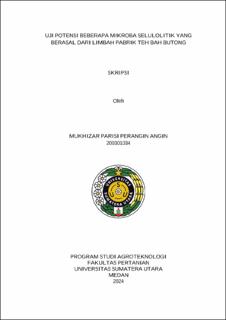Uji Potensi Beberapa Mikroba Selulolitik yang Berasal dari Limbah Pabrik Teh Bah Butong
Testing the Potential of Several Cellulolytic Microbes Originating from Waste Bah Butong Tea Factory

Date
2024Author
Angin, Mukhizar Parisi Perangin
Advisor(s)
Sembiring, Mariani Br
Metadata
Show full item recordAbstract
Tea is a leading plantation commodity in Indonesia and as a mainstay commodity that has great opportunities to be developed. Tea processing also produces 400 kg of solid waste per day, resulting in 12 tons in a month. Tea grounds contain cellulose compounds of 37%. The tea solid waste has the potential to be used as a source of organic matter and used as fertilizer for plants. The use of microbes that are able to hydrolyze cellulose is cellulolytic microorganisms that have the ability to grow on cellulose and can decompose these cellulose materials. This study aims to test the activity of cellulose enzymes and test the potential of microbes in decomposing organic matter. This research consists of several stages, namely microbial isolats are tested for the degradation potential of cellulose compounds semi-quantitatively to obtain the best isolat, the best isolats will be tested for cellulase enzyme activity quantitatively and test the potential of microbes in decomposing organic matter from raw tea waste. The results showed that the largest cellulolytic index was found in the B17S isolat code of 0.49. The activity of cellulase enzyme isolat B17S had the highest value of 0.0179 unit/mL on day 5. In the test of microbial potential in decomposing organic matter of raw tea waste for 20 days, microbes with the B17S isolat code have the potential to degrade organic matter which produces a pH of 5,41 followed by a C/N level of 9,84 and a respiration result of 3,14 mg C-CO2 g-1 hari-1 and a total population of 30.2 x 108 CFU g-1.
Collections
- Undergraduate Theses [3569]
